 |
 |
 Peninsular ( Western
)
Malaysia
( Map
)
Peninsular ( Western
)
Malaysia
( Map
) 
Johore Bahru
- Malacca
- Kuala Lumpur
:
The congested, claustrophobic, cosmopolitan streets of downtown Johore Bahru typify the rich diversity of multi-cultural, multi-racial Malaysian society with its potentially explosive cocktail of Moslem Malays ( the Bumiputra - ' the sons of the soil ', forming approx 50% of the population ), Buddhist Chinese ( approx. 35% ) and Hindu Indians ( approx 15% ) - a microcosm of Asia and a minefield of different protocols for western visitors.
Despite the multiplicity of languages and alphabets there is however little problem with communication as English is widely used and remains the lingua franca although Bahasa Malaysia has been imposed as the national language to try to foster a sense of national identity.
Escaping from the vibrant hustle and bustle I wandered around the spacious, tranquil gardens of the nearby Istana Besar ( royal palace ) with views back across the Straits of Johore to the skyscrapers of Singapore.
Insulated from the searing tropical heat in an air-conditioned coach it is only a few hours northwards along the landscaped motorway through extensive plantations of pineapples, oil palms and rubber trees to the sea-front town of Melaka ( Malacca ).
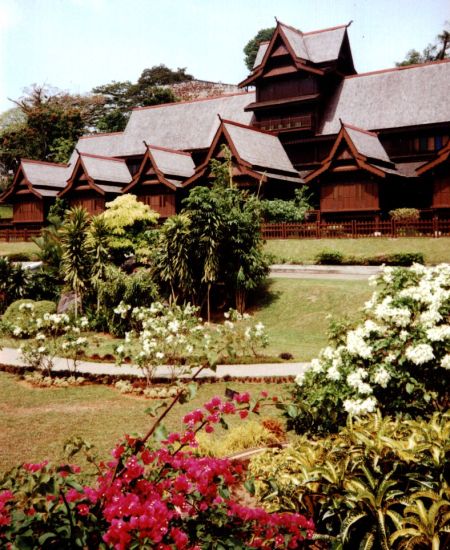 Traditional style palace in Malacca |
From the bus terminal one of the dwindling band of elderly bicycle-rickshaw drivers drove me the short distance into the historical town ' where it all began ' with the first invasion of Europeans.
Starting at the eye-catching, bright-red Christ Church I climbed above the Stadthuys, a cluster of massive, square, pink-painted buildings, ( a legacy of the Dutch ), to the ruins of St.Paul's Church, ( a legacy of the Portuguese ), on top of a small hill to gain a splendid outlook over the Straits of Malacca. The original landing site of the Portuguese is now well inland being part of the reclaimed mangrove swamps and occupied by a huge, modern shopping and leisure complex. Moored at the waterfront near the Stadthuys I could see the hydrofoils for the ferry service to Dumai across the Straits in Sumatra.
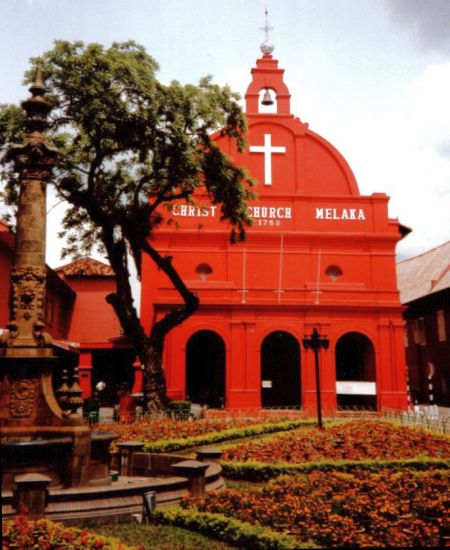 Christ Church in Malacca |
In the cool of the evening I joined the keep-fit enthusiasts on top of Bukit China - a vast Chinese graveyard with over 12,000 graves some dating back to the Ming dynasty. Chinese graveyards are commonly built on hillsides to shield the graves from evil winds and to provide the spirits with a good view of what their descendants are up to down below.
On another day I strolled round the old part of Melaka searching for treasures of the East in the numerous antique shops and exploring the many mosques, temples and clan houses squeeezed into the compact area.
A short journey up the motorway soon brings into view the high-rise sky-line of the Malaysian capital Kuala Lumpur ( or, more usually just KL, similarly JB for Johore Bahru - there is a predilection for abbreviations in Malaysia ).
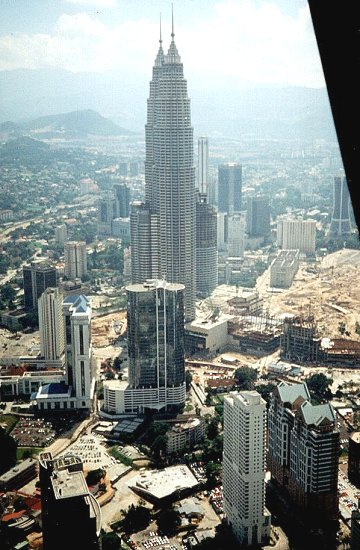 Petronas Towers from Telekom Tower |
There is also a penchant for tall buildings. From the observation platform on the 421metre Telekom Tower, the world's fourth highest, a breathtaking, bird's-eye view unfolds over the sprawling city. Clearly visible is the foundation site of the city where the early tin prospectors landed at the confluence of the sluggish, brown waters ( kuala - estuary, lumpur- muddy ) of the Klang and Gombak rivers. However the beautiful Masjid Jame ( the 'Friday Mosque' ) with its onion domes perched on elegant, red-and-white striped minarets, in a grove of palm trees at the junction of the rivers, is almost totally obscured by one of the stations for the recently constructed overhead railway snaking through the city centre.
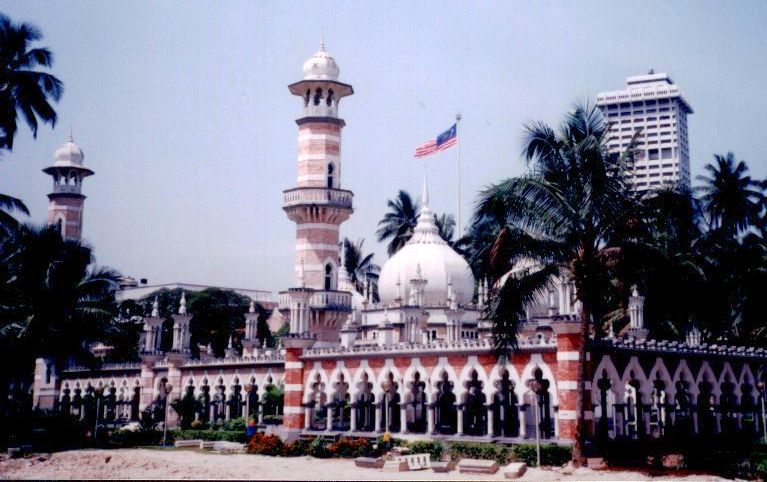 Masjid Jame ( the Friday Mosque ) in Kuala Lumpur |
Also prominent is the vivid, green rectangle of the Padang, a legacy of colonial days but where cricket still takes place, and the adjoining Merdeka ( Independence ) Square with its huge flag on a 95metre high flagpole. Only slightly further afield lies the wide green belt containing the extensive Lake Gardens - an oasis of peace and tranquility amidst the noise and bedlam of the traffic-jammed expressways.
Immediately adjacent, dwarfing the other high-rise buildings, like some gigantic rocketship awaiting take-off, are the twin Petronas Towers - temporarily the highest building in the world and a symbol of Vision 2020 - Malaysia's long term plan to become a fully developed nation by the year 2020.
A half day walk suffices to visit most places of interest. Directly opposite Merdeka Square the historic, Moorish-style, buildings are spectacularly illuminated in the evenings. Not far off is the fantastic, Railway Station with its amazing array of spires, minarets, towers, cupolas and arches. In Chinatown the air-conditioned Central Market provides welcome relief from the torrid, teeming street markets to browse through the handicrafts and artwork.
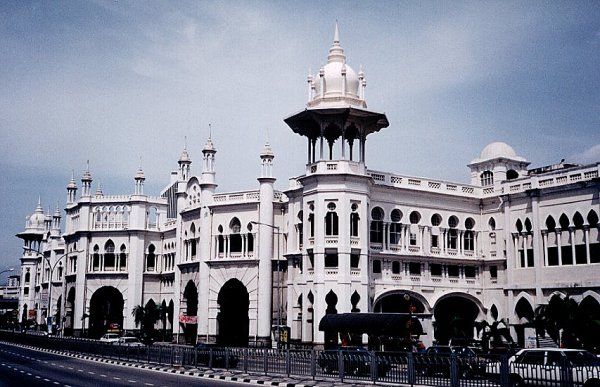 The Railway Station in Kuala Lumpur |
At least once on every visit I dine at the renowned Coliseum Hotel - a nostalgic reminder of the tea-planter days and a favourite haunt of ex-pats.
Late in the evenings the 'lady-boys', unbelievably effeminate, emerge to promenade in search of their clients.
The East Coast
:
Coping successfully with the chronic chaos and pandemonium of the Puda Raya bus station I left Kuala Lumpur to travel across the peninsula to the riverside town of Kuantan.
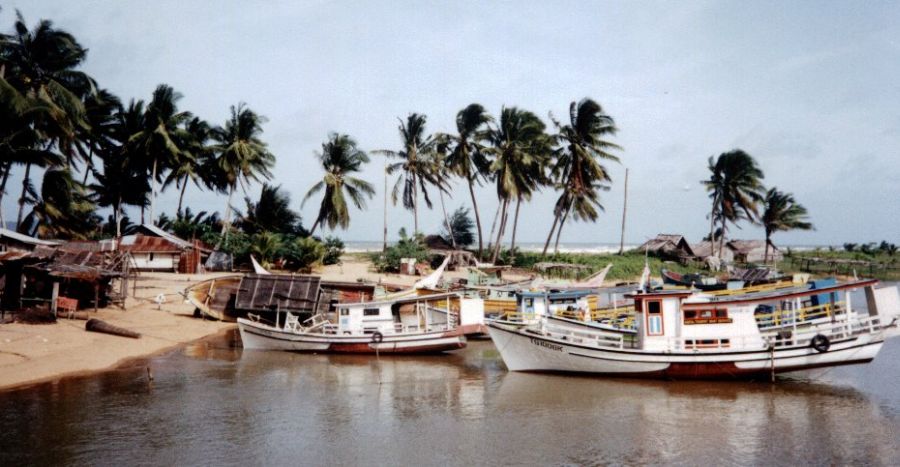 Lagoon at Marang |
Shorter stages via the picture-postcard fishing village of Marang, with its brightly-painted boats moored in a palm-fringed lagoon, Cherating with its long, white-sand beaches and the bustling coastal city of Kuala Terengganu brought me to Kota Bahru - a centre of Malay culture, crafts and religion in the NW corner of Malaysia close to the border with Thailand.
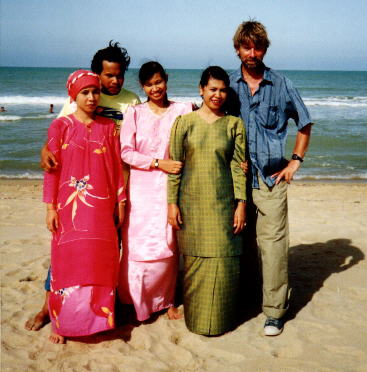 PCB beach at Kota Bahru |
Here Islamic activists agitate for the introduction of Sharia law and the Islamic calendar. Notices displayed around town illustrate what they consider to be proper and improper dress for women. They seem however to be fighting a losing battle. Most young Moslem women continue to wear the traditional sarong but have transformed it from a shapeless sack into a stylish, form-fitting, gaily-patterned, fashion garment. Malay schoolgirls, sedately attired in their uniforms like a convent of nuns, incongruously sport garish, multi-coloured, designer-label backpacks. To compound the problem for the zealots the local Chinese have no religious restrictions or inhibitions on adopting Western dress. Another grievance is the exotic name for the local beach - Pantai Cinta Behari ( PCB ) - " the Beach of Passionate Love ".
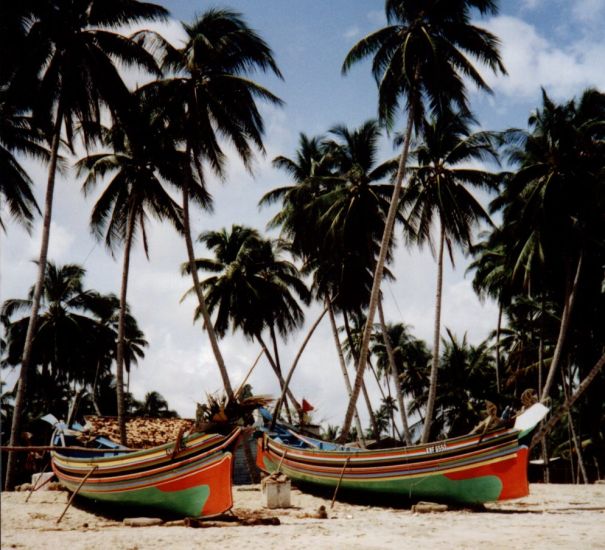 Beach near Kota Bahru |
It was at another of the local beaches, Pantai Dasar Sabak, that the Japanese stormed ashore from the South China Sea to invade the peninsula a full hour and a half before their attack on Pearl Harbour.
In the evenings I patronized the food stalls at the night market set up in the central carpark. The wide variety of Malay dishes includes the ubiquitous nasi ayam ( chicken rice ), mee goreng ( fried noodles ) and ABC ( ais batu kacang - a dessert of shaved ice with multiple flavourings ).
Across the East - West Highway:
On the northern route across the peninsula from Kota Bahru to Butterworth on the Andeman Sea the demand for bus tickets exceeds the supply - especially at the end of Ramadan when the Malays return to their kampungs ( traditional villages ) to celebrate Hari Raya ( the Moslem New Year ), and several times I have had to resort to the local blackmarket.
The highway, blazed through harsh jungle terrain and subject to monsoon washouts, runs parallel to the Thai border and gives spectacular views of Tasik Temengor ( one of Malaysia's largest lakes formed by the dam on the hydro scheme ).
Normally there is a lunch stop on the seven hour journey but on one trip the bus failed to stop - eventually realizing it was Ramadan ( when Moslems are forbidden to eat from sun-rise to sun-set ) I surreptitiously tried to eat a Mars bar without attracting the attention of the other passengers - mostly young Malay women returning to their jobs on the production lines in the factories of Butterworth.
On another trip the bus remained unexpectedly stopped for a prolonged period - the driver had abandoned his passengers and gone off to a nearby mosque to perform his midday prayers.
Pulau Pinang
- " The Pearl of the Orient ";
Rather than crossing the 3Km bridge, the longest in Asia, between Penang Island and the mainland I took the much more scenic ferry from Butterworth to cross the channel to Georgetown - the oldest British settlement in Malaysia predating Malacca and Singapore.
Another short ride by bicycle rickshaw brought me to the White House - typical of the local hotels, universally run by Chinese, that I stay in. The large, impeccably clean room, with double bed, nicely tiled walls and floor, washstand and integral shower room cost 28 ringgit ( malaysian dollars, £1 = M$4 ) per night - the most expensive of my journey. ( The cheapest, but not the worst, was the Cathay Hotel in Malacca at M$20 per night ).
Georgetown is the Chinese capital of Malaysia - an embryo Singapore or Hong Kong. Cloistered within its bustling bazaars and street markets are a multiplicity of gaudy temples and ornate clan houses. On the outskirts, the Kek Lok Si Temple, with its seven-tier, 30metre Ban Po Thar ( 'Ten Thousand Buddhas' Pagoda' ), is the largest Buddhist Chinese temple in Malaysia. Wandering the streets of the old town one can hear the clatter of mahjong tiles from inside the houses while the main language in use amongst the polyglot citizens is Cantonese.
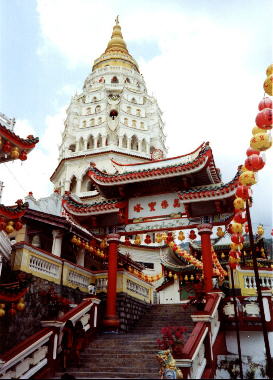 Kek
Lok Si Temple in Penang |
On an afternoon, to escape the oppressive heat, I took the funicular railway to the top of the 830metre Penang Hill - one of the earliest hill resorts. Despite the haze there was a fine view of the city below and across to the mainland. In the extensive, monkey infested, Botanical Gardens at the foot of the hill there is only one season - summer all year round - a problem for deciduous trees.
The most popular beach on Penang is the long stretch of white sand at Batu Ferringi ( Foreigner's Rock ) - a 20 minute bus ride from Georgetown. Nicer beaches are more difficult to access. After an arduous two hour jungle trek I emerged onto the idyllic Mermaid Beach. However I only had it to myself for a short time before there was an invasion by two boatloads of young Malaysians. Continuing along the beach I climbed through coconut palms to the lighthouse on the rocky promontory of Muka Head for a superb view back along the northern coast of the island.
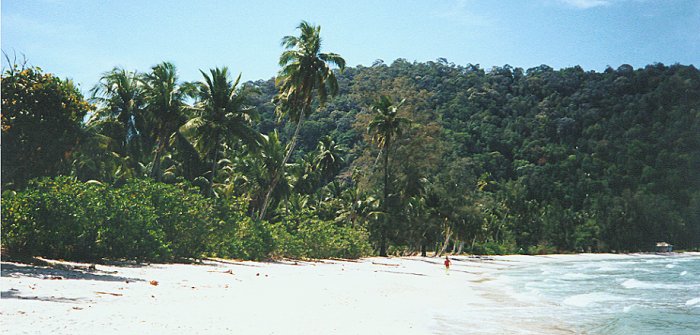 Mermaid
Beach on Penang Island
|
|
Near to the ruins of Fort Cornwallis on the esplanade is the quay for the hydrofoil service to Medan in Sumatra - the starting point for a loop through the Indonesian Island that I had made the previous year terminating at Dumai for the return ferry to Malacca.
Apart from the many old colonial government buildings in Georgetown another legacy of the British is the number of restaurants with Fish 'n' Chips on their menus.
North to the Thai Border:
A half day sufficed to reach the untouristed Alor Setar to the North of Butterworth where a superb view extends from the top of the new Telekom Tower over the compact city surrounded by a vast, green sea of lush, paddy fields - the rice bowls of Malaysia. Immediately below are the historic buildings of the town square with the elegant, onion-domed Zahir Mosque.
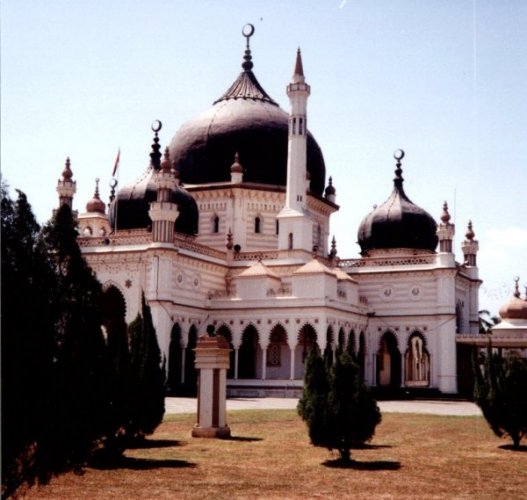 Zahir State Mosque in Alor Star |
At the nearby port of Kuala Kedah I took the hydrofoil to Pulau Langkawi - another of Malaysia's tropical island paradises ( it was on Pulau Tioman off the SE coast that "South Pacific" was filmed ).
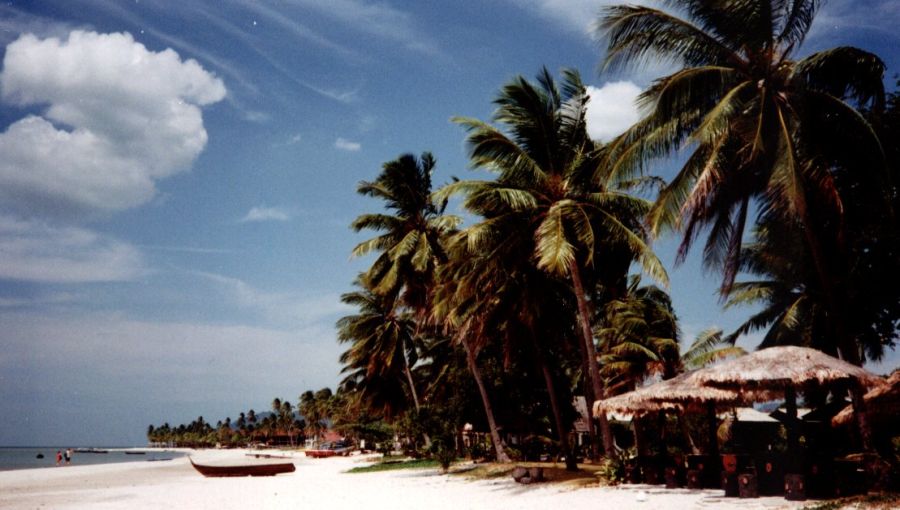 Beach on Langkawi |
It is possible to cross directly to Thailand by ferry from Langkawi ( or from the mainland at the nearby port of Kuala Perlis ) but on this occasion I chose the overland route from Alor Setar via Kangar to the small town of Padang Besar - a centre for cross-border trade ( legal and illegal ). After changing the last of my ringgits into Thai Bahts a short ride by motorbike-taxi brought me to the checkpoint at the Malaysian frontier with Thailand.
The total cost of my bus fares for my four week journey from Singapore amounted to some M$80 ( approx. £20 ).